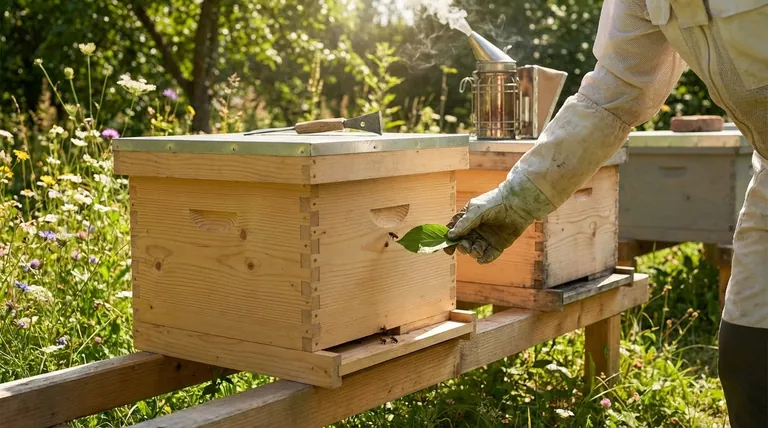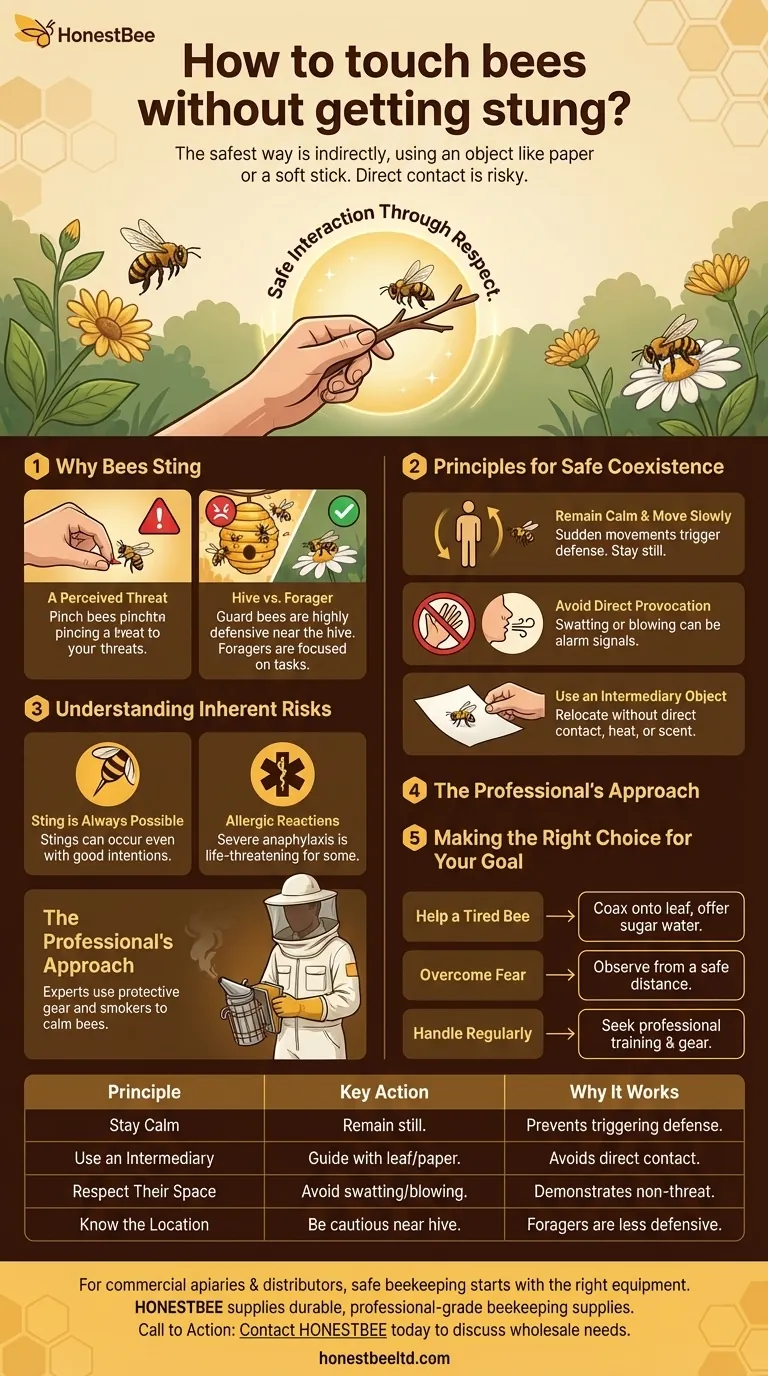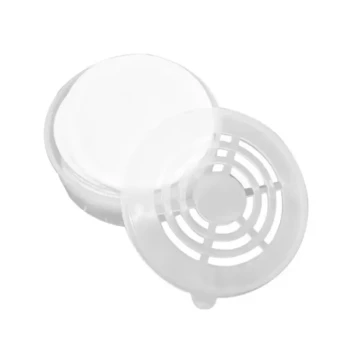The safest way to touch a bee is indirectly, using an object like a piece of paper or a soft stick to gently guide it. Direct contact with your bare hands is highly risky and not recommended, as bees sting to defend themselves against perceived threats like being squeezed or trapped.
The core principle isn't about the physical act of touching, but about understanding a bee's defensive nature. Safe interaction comes from respecting the bee's space and avoiding any action that could be interpreted as a threat.

Why Bees Sting in the First Place
A bee sting is not an act of aggression; it is a defensive last resort. Understanding what triggers this response is the key to preventing it.
The Bee's Perspective: A Perceived Threat
A bee stings when it feels its life or its colony is in danger. Actions that feel threatening include being pinched, squeezed, swatted, or trapped against a surface.
Sudden, jerky movements can also be interpreted as predatory, triggering a defensive reaction.
The Hive vs. The Individual Forager
A bee's defensiveness is highly dependent on its location. A bee foraging for nectar on a flower, far from its hive, is focused on its task and is much less likely to sting unless directly provoked.
Bees near their hive entrance are on high alert. Their primary role is to act as guards, and they will be far more sensitive to any perceived disturbance.
Principles for Safe Coexistence
Instead of focusing on touching, aim to coexist safely by demonstrating through your actions that you are not a threat.
Remain Calm and Move Slowly
If a bee is near you or lands on you, your best strategy is to stay still. Panicked reactions, like flailing your arms, are what often lead to stings.
Slow, deliberate movements are far less alarming to an insect than quick, unpredictable ones.
Avoid Direct Provocation
Never swat at a bee or blow on it. The carbon dioxide in your breath can be an alarm signal for some bee species, escalating the situation.
If a bee is inside a building, it's lost and wants to get out. Gently guide it toward an open window or trap it in a container and release it outside.
Use an Intermediary Object
If you must move a bee—for instance, one that seems tired or is in a dangerous spot—do not use your fingers.
Gently slide a piece of paper, a leaf, or a small stick under the bee. This allows you to relocate it without the direct contact, heat, and scent from your hand, which can be frightening for the insect.
Understanding the Inherent Risks
Even with the calmest demeanor, interacting with bees carries unavoidable risks. It's critical to acknowledge them.
A Sting is Always Possible
You cannot fully control how a bee will interpret your actions. A bee can be startled for reasons you don't perceive, and a defensive sting can occur even with the best intentions.
The Dangers of Allergic Reactions
For some individuals, a bee sting can cause a severe allergic reaction (anaphylaxis), which can be life-threatening. If you have a known bee allergy, you should avoid any close contact.
The Professional's Approach
Beekeepers, who handle bees constantly, do not rely on gentleness alone. They use protective veils, gloves, and smokers. A smoker calms the bees by masking their alarm pheromones, making them less likely to organize a defensive response. This professional toolkit underscores that even experts prioritize safety gear.
Making the Right Choice for Your Goal
Your approach should be dictated by your specific goal.
- If your primary focus is to help a tired or cold bee: Gently coax it onto a leaf or piece of paper and offer it a small drop of sugar water to help it recover its energy.
- If your primary focus is overcoming a fear of bees: Start by observing them from a safe distance in a garden. Watch their behavior and learn to appreciate their role without feeling the need to interfere.
- If your primary focus is to handle bees regularly: Seek out a local beekeeping course. This will provide the proper training and knowledge to handle bees safely with the correct protective equipment.
Ultimately, the most reliable way to interact with bees without getting stung is to give them the space they need to do their vital work.
Summary Table:
| Principle | Key Action | Why It Works |
|---|---|---|
| Stay Calm | Remain still and move slowly. | Prevents triggering the bee's defensive instincts. |
| Use an Intermediary | Guide the bee with a leaf or paper. | Avoids direct contact, heat, and scent from your hand. |
| Respect Their Space | Avoid swatting, blowing, or sudden movements. | Demonstrates you are not a threat. |
| Know the Location | Be extra cautious near a hive. | Foraging bees are less defensive than guard bees at the hive. |
For commercial apiaries and distributors, safe and efficient beekeeping starts with the right equipment. HONESTBEE supplies durable, professional-grade beekeeping supplies and equipment designed for high-volume operations. Our wholesale-focused solutions help you manage your colonies safely and productively.
Contact HONESTBEE today to discuss your wholesale needs and enhance your beekeeping operation.
Visual Guide

Related Products
- Wholesales Dadant Size Wooden Bee Hives for Beekeeping
- Yellow Plastic Bucket Pail Perch for Beekeeping
- Professional Insulated Winter Hive Wrap for Beekeeping
- Long Langstroth Style Horizontal Top Bar Hive for Wholesale
- Automatic Honey Flow Beehive 4 Frame Mini Hive for Beekeeping
People Also Ask
- What are the characteristics of oil-based paint for beehives? Durability vs. Modern Practicality
- How often should the area under beehives be inspected and cleaned during the warm season? A Proactive Maintenance Guide
- What is beekeeping equipment? Essential Tools for Commercial Apiaries & Distributors
- What are the essential pieces of equipment for most beekeepers? Get Started with the Right Gear
- What are the advantages of wooden bee hives? Superior Bee Health & Beekeeper Flexibility



















